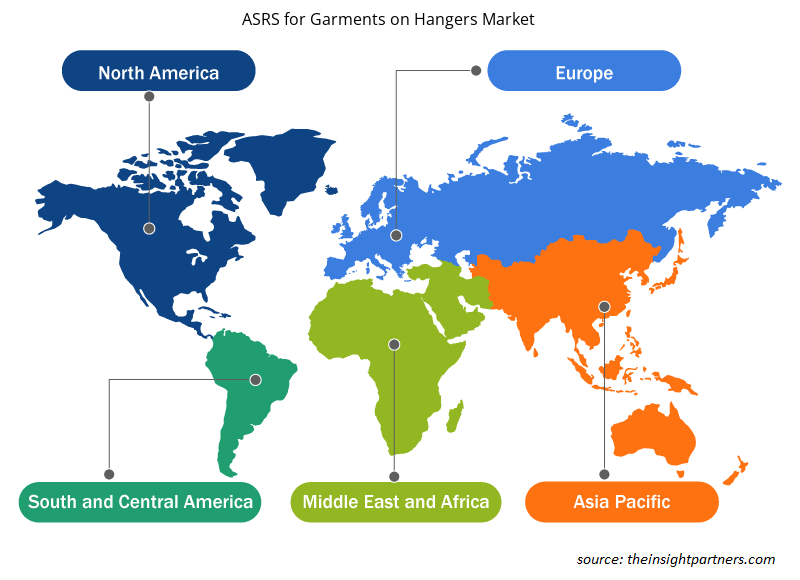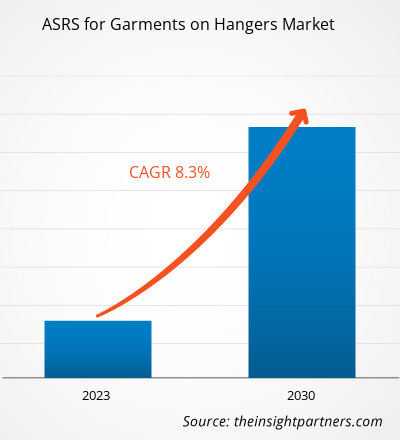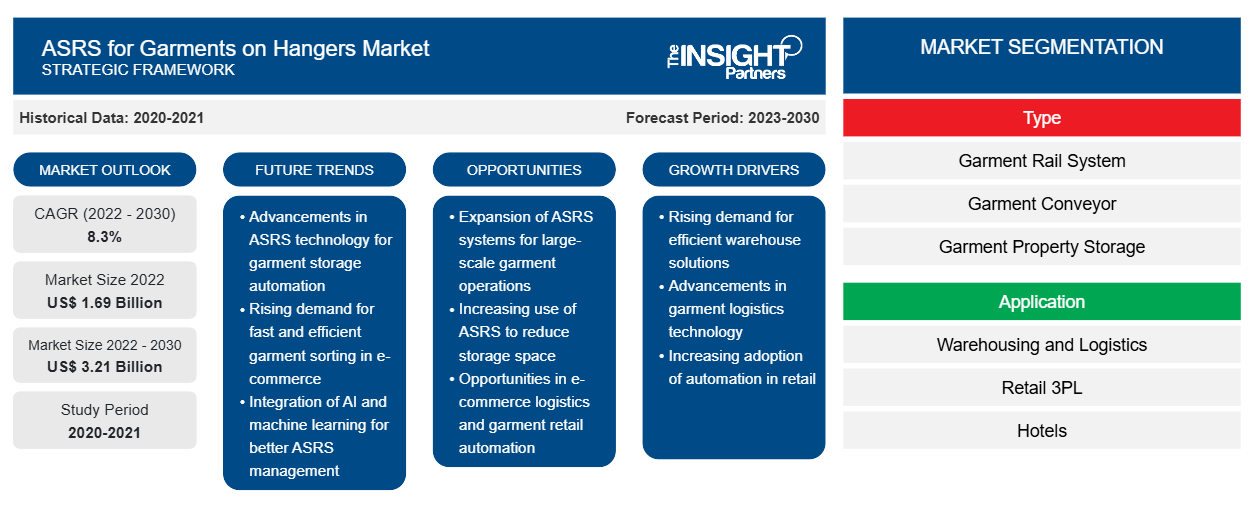[調査レポート] ハンガーに掛けられた衣類の自動倉庫(ASRS)市場規模は、2022年に16億9,000万米ドルと評価され、2030年までに32億1,000万米ドルに達すると予想されています。また、2022年から2030年にかけて8.3%のCAGRを記録すると予測されています。
アナリストの視点:
自動倉庫システム(ASRSシステムとも呼ばれる)は、製造施設や流通施設で広く使用されています。通常、棚の大部分を置き換えて床面積を節約し、安全性を高め、生産性を高めます。これらのシステムは、アイテムの保管と配送時間の最適化により、成長を続けるeコマースおよび小売業界で勢いを増しています。また、世界中の流通および物流センターは、保管と検索のプロセスを自動化するためにこれらのシステムの採用で市場をリードしています。ハンガーに掛けた衣類用の新しいASRS市場のプレーヤーの出現は、技術革新によって市場に新たな機会をさらに生み出しています。ハンガーに掛けた衣類用のASRS市場の予測は、Factiva、企業プロファイル、年次報告書、さまざまな協会などから取得した二次データに基づいています。
ハンガーに掛けられた衣類の ASRS 市場の概要:
ハンガーに掛けられた衣類用の自動倉庫のグローバル市場分析に基づくと、自動倉庫システムは、シングル/ダブルマスト、伸縮フォーク/独自設計のダイレクトロールフォーク(生地ロールの保管と取り出し専用)、カスタム設計のラックを使用して設計されており、このソリューションは幅広い高速アプリケーションに対して非常に適応性が高く、スムーズで安全です。上記のすべてのコンポーネントとアプリケーションは、レポートのハンガーに掛けられた衣類用の自動倉庫の市場規模を評価するために分析されています。
自動倉庫管理システム (ASRS) は、織物、編み物、衣服の加工を行うあらゆる繊維施設において、材料の流れと生産パフォーマンスを改善できます。理想的な資材処理システムは、材料の輸送時間を短縮すると同時に、重要な材料がエラーや損傷なく安全に使用場所まで移動されることを保証します。たとえば、縫製部門の資材処理システムは、ライン アーキテクチャに基づいて調整され、生地のロールをワークステーション間でシームレスに輸送したり、保管や裁断を行ったりすることができます。ASRS は繊維業界でいくつかの利点があります。ASRA は、ERP 統合によりスマート在庫を管理し、資材の移動と物流の人員を節約し、倉庫の床面積を効率的に利用できます。また、保管から生産までの資材の移動を完全に制御できるほか、資材の安全な取り扱い、迅速な資材の流れ、FIFO も実現します。市場は、e コマースの成長の高まり、労働力不足による ASRS の需要の高まり、世界的な都市化の進行など、いくつかの重要な要因によって推進されています。また、この市場では、他のテクノロジーとの強化された注文処理統合など、今後数年間で成長を促進するいくつかの機会が訪れることが予想されており、これにより、ハンガーに掛けられた衣類用の ASRS の市場シェアが世界市場で拡大することになります。
ハンガーに掛けた衣類用 ASRS 市場の分析は、タイプ、アプリケーション、および地理に基づいています。タイプに基づいて、ハンガーに掛けた衣類用 ASRS 市場は、衣類レール システム、衣類コンベア、衣類資産保管、およびその他のカテゴリに分類されます。アプリケーション別に、ハンガーに掛けた衣類用 ASRS 市場は、倉庫および物流、小売 3PL、ホテル、病院および機関、およびその他のカテゴリに分類されます。地理に基づいて、ハンガーに掛けた衣類用 ASRS 市場は、北米、ヨーロッパ、アジア太平洋、中東およびアフリカ、および南米に分類されます。
Ferag、SDI element logic、Schonenberger、Beumer Group、Vanderlande、Dematic、KNAPP、Daifuku、ABCO、Railex、Conveyco、White Conveyor は、この市場調査で紹介されている主要企業の一部です。これらの企業に加えて、他の重要な市場企業も調査および分析され、ハンガーに掛けられた衣類用の ASRS の世界市場シェアとそのエコシステムの全体像を把握しています。
要件に合わせてレポートをカスタマイズする
このレポートの一部、国レベルの分析、Excelデータパックなど、あらゆるレポートを無料でカスタマイズできます。また、スタートアップや大学向けのお得なオファーや割引もご利用いただけます。
-
このレポートの主要な市場動向を入手してください。この無料サンプルには、市場動向から見積もりや予測に至るまでのデータ分析が含まれます。
ハンガーに掛けられた衣類の ASRS 市場の推進要因:
労働力不足による需要の急増がハンガーに掛けられた衣類の自動倉庫市場の成長を促進
近年、衣料品業界では、労働力不足による課題を克服するために自動化への大きなシフトが起こっています。効率的な注文処理と保管ソリューションの需要が高まるにつれ、企業は自動保管および検索システム(ASRS)を実行可能なソリューションとして採用しています。たとえば、2022年2月にInstaworkが実施した調査によると、倉庫運営者の73%がビジネスニーズを満たすために労働者を雇うことに課題を抱えています。この労働力不足は衣料品業界で大きな懸念事項となっており、ソリューションとしてのASRSの需要が高まっています。
小売売上高と企業在庫レベルが好調であるにもかかわらず、倉庫業界の労働市場は低迷しています。労働統計局のデータによると、2023年1月には倉庫関連の雇用が13,400件増加し、国内の雇用数は1,728,200件に上りました。しかし、業界では依然として人員不足の問題が残っています。ASRSは、衣料品業界の保管、取り出し、仕分けプロセスを自動化することで、省力化ソリューションを提供します。ASRSシステムを実装することで、企業は手作業による労働集約的なタスクへの依存を減らし、労働力不足がもたらす課題を克服できます。
さらに、労働力不足は、雇用主が利用可能な労働者を獲得するために競争しなければならないため、人件費の増加につながることがよくあります。GOH 用の ASRS を実装することで、企業は手作業への依存と関連コストを削減できます。これらのシステムは、人件費を最小限に抑え、スペース利用を最適化し、注文処理のエラーを削減することで、長期的な投資収益率 (ROI) を提供します。人件費が削減され、運用効率が向上するため、企業は R&D やマーケティングイニシアチブ、その他の重要な分野にリソースを割り当てることができます。したがって、労働力不足による需要の急増は、ハンガーに掛けられた衣類用の ASRS 市場の成長を促進します。
ハンガーに掛けられた衣類の ASRS 市場セグメント分析:
タイプに基づいて、ハンガーに掛けられた衣類用の ASRS 市場は、衣類レール システム、衣類コンベヤー、衣類資産保管、その他に分類されます。衣類レール システムは、衣類メーカー、配送センター、ランドリー、小売業界で使用されています。手動レール システムまたは完全に自動化された検索システムを組み込んでおり、生産性を最大化するのに役立ちます。これらの衣類配送コンベヤーは、衣類の自動ロードとアンロードを特徴としています。多くの ASRS セットアップでは、衣類レール システムは、垂直方向の保管スペースを最大化するために、複数のレベルまたは層にわたって動作するように設計されています。注文が行われると、ASRS システムは要求された衣類の場所を識別し、レール システムから自動的に取り出します。レール システムには、注文要件に基づいて取り出しプロセスを合理化するための仕分けメカニズムを含めることができます。ハンガーに掛けられた衣類用の ASRS 市場における衣類レール システムは、自動衣類保管および取り出しシステムの効率、精度、および全体的なパフォーマンスに不可欠です。これは、吊り下げられた衣類の完全性を維持することが注文の履行に不可欠である衣料品業界の独自の要件に対応します。
ハンガーに掛けられた衣類の ASRS 市場の地域分析:
米国、カナダ、メキシコは、技術開発の中心地と見なされている北米の主要国です。IoTの人気が高まる中、米国の企業は自動化されたストレージソリューションを使用してこの技術を実装しており、時間とコストを節約できます。 IoT統合型の自動ストレージソリューションにより、リモート監視、タイムリーなレポートステータスの生成、エラーが発生した場合の迅速な回復、効率の向上が可能になります。 モントリオールは北米のファッションの中心地です。 1世紀以上にわたって、繊維のデザイン、製造、取り扱いにおけるイノベーションの中心地となっています。 そのため、北米のいくつかのプレーヤーは、ハンガーに掛けられた衣類のASRS市場におけるソリューションの開発に注力しています。 たとえば、2021年4月の時点で、Planiformは、ハンガーに掛けられた衣類(GOH)の保管と取り出しのための革新的な自動化システムを発売しました。 2021年7月には、GOH Hiveが発売され、倉庫、配送センター、eコマースビジネスなど、さまざまな衣類取り扱いビジネスから称賛されることが期待されています。 GOH Hive は、ユニークな SKU を読み取り、各衣類の取り扱い方法を決定するインテリジェント ロボットを搭載した最先端のシステムです。このシステムは複数のレベルで設計されており、ロボットはエレベーターを使用して出荷準備が整った衣類の列にアクセスします。さらに、この地域の複数のプレーヤーがハンガーに掛けられた衣類の ASRS 市場でソリューションを提供しています。たとえば、Dematic は、在庫を減らして移動できるように設計された幅広いストレージ オプションを提供しています。同社は、パレット、カートン (トート)、ハンガーに掛けられた衣類の商品の整理と管理を支援できます。したがって、このような事例は、北米のハンガーに掛けられた衣類の ASRS 市場の成長を促進します。
ハンガーに掛けた衣類の ASRS 市場の主要プレーヤー分析:
Ferag、SDI element logic、Schonenberger、Beumer Group、Vanderlande、Dematic、KNAPP、Daifuku、ABCO、Railex、Conveyco、White Conveyor は、ハンガーに掛けた衣類用 ASRS 市場レポートで紹介されている著名な市場プレーヤーです。ハンガーに掛けた衣類用 ASRS 市場予測は、この市場の関係者が成長戦略を計画するのに役立ちます。
ハンガーに掛けられた衣類の ASRS 市場地域別インサイト
予測期間を通じてハンガー付き衣類用ASRS市場に影響を与える地域的な傾向と要因は、Insight Partnersのアナリストによって徹底的に説明されています。このセクションでは、ハンガー付き衣類用ASRS市場のセグメントと、北米、ヨーロッパ、アジア太平洋、中東、アフリカ、南米、中米の地理についても説明します。

- ハンガーに掛けられた衣類のASRS市場の地域固有のデータを入手
ハンガーに掛けられた衣類の ASRS 市場レポートの範囲
| レポート属性 | 詳細 |
|---|---|
| 2022年の市場規模 | 16億9千万米ドル |
| 2030年までの市場規模 | 32億1000万米ドル |
| 世界のCAGR(2022年 - 2030年) | 8.3% |
| 履歴データ | 2020-2021 |
| 予測期間 | 2023-2030 |
| 対象セグメント |
タイプ別
|
| 対象地域と国 |
北米
|
| 市場リーダーと主要企業プロフィール |
|
市場プレーヤーの密度:ビジネスダイナミクスへの影響を理解する
ハンガーに掛けた衣類用の自動倉庫市場は、消費者の嗜好の変化、技術の進歩、製品の利点に対する認識の高まりなどの要因により、エンドユーザーの需要が高まり、急速に成長しています。需要が高まるにつれて、企業は提供内容を拡大し、消費者のニーズを満たすために革新し、新たなトレンドを活用し、市場の成長をさらに促進しています。
市場プレーヤー密度とは、特定の市場または業界内で活動している企業または会社の分布を指します。これは、特定の市場スペースに、その市場規模または総市場価値に対してどれだけの競合相手 (市場プレーヤー) が存在するかを示します。
ハンガー付き衣類のASRS市場で事業を展開している主要企業は次のとおりです。
- フェラグAG
- エレメントロジックUSビッドコ社
- ABCOシステムズLLC
- シェーネンベルガー システム GmbH
- BEUMERグループ株式会社
免責事項:上記の企業は、特定の順序でランク付けされていません。

- ハンガー付き衣類用ASRS市場のトップキープレーヤーの概要を入手
最近の動向:
ハンガーに掛けた衣類用の自動倉庫市場の企業では、合併や買収などの無機的および有機的な戦略が広く採用されています。ハンガーに掛けた衣類用の自動倉庫市場の最近の主要な動向をいくつか以下に示します。
- 2023年5月、Feragはアジア市場への取り組みを強化しました。システムインテグレーターのASETECのサポートにより、Feragの包括的なイントラロジスティクスソリューションは韓国でますます利用されるようになります。このため、両社は提携に合意しました。
- 2022年3月、AutoStoreシステムを中心とした自動倉庫ソリューションの専門インテグレーターであるElement Logicは、米国の大手ターンキー自動化ソリューションおよび仕分けシステムプロバイダーであるSDI Industriesの買収を発表しました。
- 2022年5月、BEUMERグループは搬送システムおよび積載技術のサプライヤーであるマクデブルクのFAM GmbHを買収しました。5月末までに取引を完了するための契約が締結されました。これにより、大型機器分野におけるBEUMERグループの市場ポジションも大幅に強化されました。
- 過去2年間の分析、基準年、CAGRによる予測(7年間)
- PEST分析とSWOT分析
- 市場規模価値/数量 - 世界、地域、国
- 業界と競争環境
- Excel データセット
最新レポート
お客様の声
購入理由
- 情報に基づいた意思決定
- 市場動向の理解
- 競合分析
- 顧客インサイト
- 市場予測
- リスク軽減
- 戦略計画
- 投資の正当性
- 新興市場の特定
- マーケティング戦略の強化
- 業務効率の向上
- 規制動向への対応























 無料サンプルを入手 - ハンガー市場向け衣類自動倉庫
無料サンプルを入手 - ハンガー市場向け衣類自動倉庫